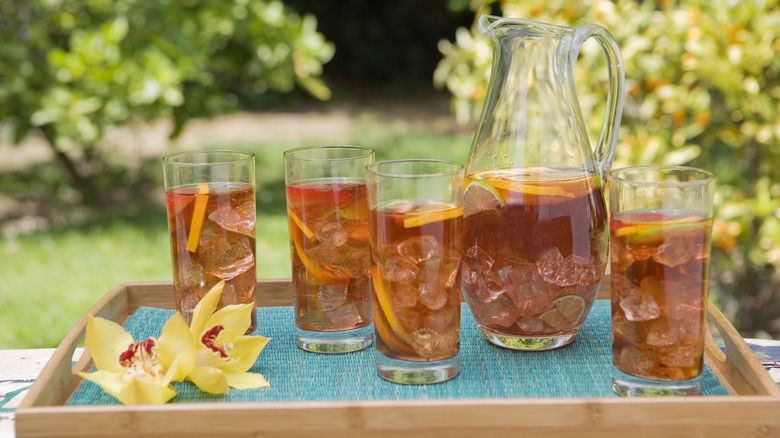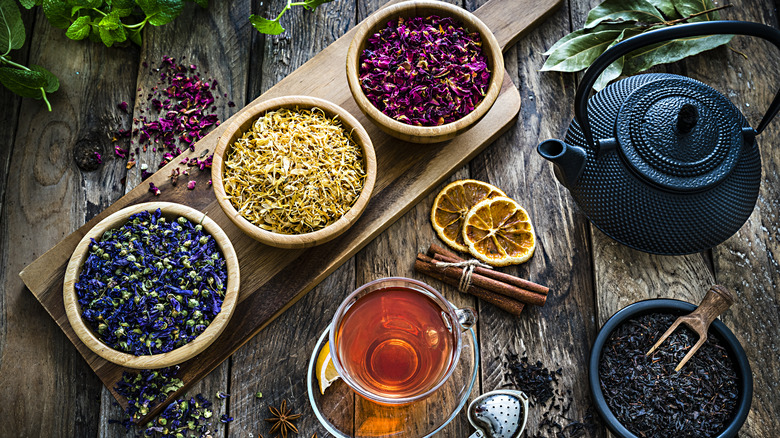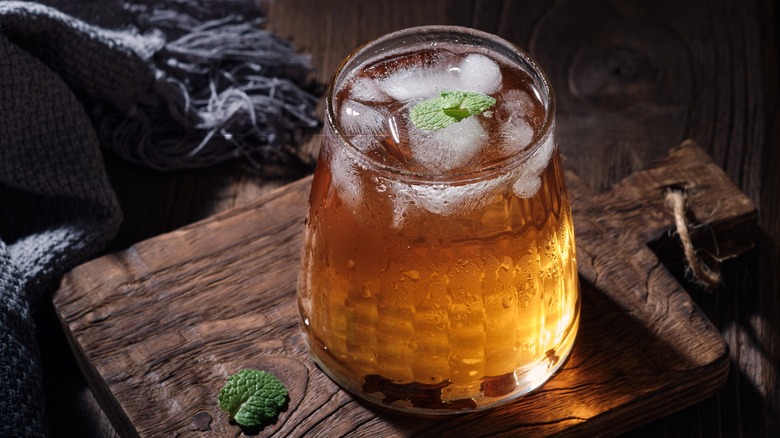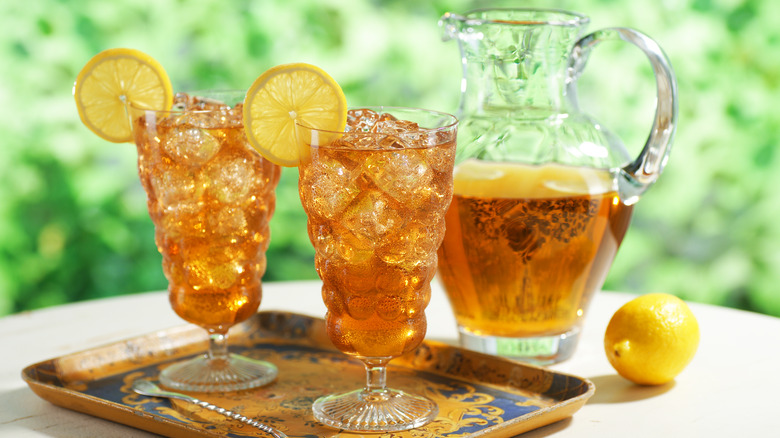Elevate Your Iced Tea By Simply Switching To Loose Leaf
If you happen to be friends with tea aficionados, they will no doubt inform you that tea brewed with loose leaf has ten times more flavor than a cuppa brewed with a tea bag. Run-of-the-mill tea, the kind you'll find at the grocery store, is made with fannings and dust, which are byproducts of the tea leaf crushing process and are generally considered to be lesser quality. Loose leaf, however, is the purest form of tea available for purchase. Not only is it excellent for making standard cups or pots of hot tea, but it is also absolutely brilliant for iced tea.
Knowing how to make iced tea at home is a must for when the weather turns hot. It's an incredibly easy task, though you will want to be careful about your tea steeping temperature and the sweeteners you add in. And if you're looking to make some iced tea with the most elevated flavor possible, you need to be brewing with loose leaves.
Generic teabags tend to have a more bitter flavor and are generally only good for one steeping. Loose leaf tea has more direct contact with the water, allowing more flavor to be extracted, and can be good for a couple of steeps. And as far as variety goes, there is plenty to choose from.
Choosing your loose leaf tea
Now, when it comes to loose leaf, you have a much wider variety of teas to choose from than what you can find at the grocery store. Most bagged teas are either some kind of black tea, like Earl Grey, green tea, or fruit and herbal teas, like peach and mint. With loose leaf, you have a seemingly endless amount of classic and creative teas.
Loose leaf comes are sold either as whole or broken leaf tea, which are the two highest grades of tea. Whole leaf is made from whole, dried tea leaves, while the broken leaf is a tea that's been dried and crushed, but still maintains that whole-leaf flavor. The tea is split into categories: black, green, herbal, pu-erh, oolong, and white. From those categories come several subcategories and blends.
Any loose-leaf tea will steep up well for multiple batches of iced tea. If you are just starting out with loose leaf, however, stick with familiar varieties like black, green, and herbal teas. These have a more familiar base flavor and work well with a variety of fruits and sweeteners. Some recommendations we love include Ceylon (black), Jasmine (green), and Rooibos (herbal). But don't be afraid to get out of your comfort zone either.
Hot brewing methods to make iced tea
Before you start any brew, it's important to know your measurements. The measurements for iced tea are the same as they are for hot tea. In general, you want 1 or 2 teaspoons of tea leaves for every 8 ounces of water. So, if you are making a gallon pitcher of iced tea, you will need 16 teaspoons of tea leaves.
One of the basic steeping methods for loose-leaf iced tea is known as the hot brew. You boil water, pour it straight into the pitcher with the tea, and allow it to steep. You'll need to allow the tea to come to room temperature in the pitcher, especially if it's glass, before popping it in the fridge or adding ice. Essentially, this is hot brewed tea on a larger scale, and you have to wait a while before you enjoy it.
There are a few reasons this might not be the best method for doing loose-leaf iced tea. First, it's labor intensive. Second, the hot water can over-extract the tannins in the tea, causing it to be bitter and astringent. There is more wiggle room with loose-leaf tea than there is for bagged tea where this method is concerned, but there are two alternatives worth considering if you want to get the most out of your loose-leaf tea.
Cold and ambient steeping
There is a steeping method known simply as cold brew tea. Essentially, you steep the tea in the cold water in the fridge for several hours. The cold water doesn't steep out the tannins as hot water does, elevating the tea's sweetness while downplaying its bitterness. You can really play the long game with this method, as tea brewed anywhere from eight to 24 hours is going to be flavorful and refreshing. The best teas for this method are white, green, and oolong.
There is also an in-between cold and hot method called ambient steeping, where the tea is steeped at room temperature for about an hour. There's no boiling water and no long refrigeration. Ambient steeping draws a lot more flavor out of the tea than cold steeping, with the water being just warm enough to extract flavors, and not being hot enough to make them overly astringent.
You can easily get lost in the never-ending maze that is loose-leaf tea. Fortunately, there are many companies that specialize in these teas and draw upon a wide array of resources and ancient wisdom. If you know of a company nearby, give them a visit. They will more than likely be happy to share their knowledge with you. And what you'll get is a newfound appreciation for loose-leaf tea.



